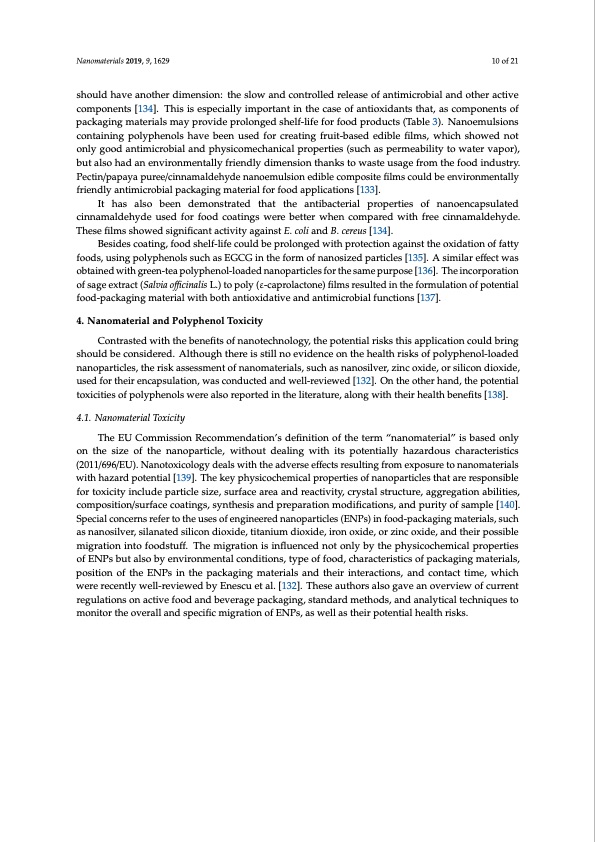
PDF Publication Title:
Text from PDF Page: 010
Nanomaterials 2019, 9, 1629 10 of 21 should have another dimension: the slow and controlled release of antimicrobial and other active components [134]. This is especially important in the case of antioxidants that, as components of packaging materials may provide prolonged shelf-life for food products (Table 3). Nanoemulsions containing polyphenols have been used for creating fruit-based edible films, which showed not only good antimicrobial and physicomechanical properties (such as permeability to water vapor), but also had an environmentally friendly dimension thanks to waste usage from the food industry. Pectin/papaya puree/cinnamaldehyde nanoemulsion edible composite films could be environmentally friendly antimicrobial packaging material for food applications [133]. It has also been demonstrated that the antibacterial properties of nanoencapsulated cinnamaldehyde used for food coatings were better when compared with free cinnamaldehyde. These films showed significant activity against E. coli and B. cereus [134]. Besides coating, food shelf-life could be prolonged with protection against the oxidation of fatty foods, using polyphenols such as EGCG in the form of nanosized particles [135]. A similar effect was obtained with green-tea polyphenol-loaded nanoparticles for the same purpose [136]. The incorporation of sage extract (Salvia officinalis L.) to poly (ε-caprolactone) films resulted in the formulation of potential food-packaging material with both antioxidative and antimicrobial functions [137]. 4. Nanomaterial and Polyphenol Toxicity Contrasted with the benefits of nanotechnology, the potential risks this application could bring should be considered. Although there is still no evidence on the health risks of polyphenol-loaded nanoparticles, the risk assessment of nanomaterials, such as nanosilver, zinc oxide, or silicon dioxide, used for their encapsulation, was conducted and well-reviewed [132]. On the other hand, the potential toxicities of polyphenols were also reported in the literature, along with their health benefits [138]. 4.1. Nanomaterial Toxicity The EU Commission Recommendation’s definition of the term “nanomaterial” is based only on the size of the nanoparticle, without dealing with its potentially hazardous characteristics (2011/696/EU). Nanotoxicology deals with the adverse effects resulting from exposure to nanomaterials with hazard potential [139]. The key physicochemical properties of nanoparticles that are responsible for toxicity include particle size, surface area and reactivity, crystal structure, aggregation abilities, composition/surface coatings, synthesis and preparation modifications, and purity of sample [140]. Special concerns refer to the uses of engineered nanoparticles (ENPs) in food-packaging materials, such as nanosilver, silanated silicon dioxide, titanium dioxide, iron oxide, or zinc oxide, and their possible migration into foodstuff. The migration is influenced not only by the physicochemical properties of ENPs but also by environmental conditions, type of food, characteristics of packaging materials, position of the ENPs in the packaging materials and their interactions, and contact time, which were recently well-reviewed by Enescu et al. [132]. These authors also gave an overview of current regulations on active food and beverage packaging, standard methods, and analytical techniques to monitor the overall and specific migration of ENPs, as well as their potential health risks.PDF Image | Polyphenol-Loaded Nanoparticles in Food Industry

PDF Search Title:
Polyphenol-Loaded Nanoparticles in Food IndustryOriginal File Name Searched:
nanomaterials-09-01629.pdfDIY PDF Search: Google It | Yahoo | Bing
Turbine and System Plans CAD CAM: Special for this month, any plans are $10,000 for complete Cad/Cam blueprints. License is for one build. Try before you buy a production license. More Info
Waste Heat Power Technology: Organic Rankine Cycle uses waste heat to make electricity, shaft horsepower and cooling. More Info
All Turbine and System Products: Infinity Turbine ORD systems, turbine generator sets, build plans and more to use your waste heat from 30C to 100C. More Info
CO2 Phase Change Demonstrator: CO2 goes supercritical at 30 C. This is a experimental platform which you can use to demonstrate phase change with low heat. Includes integration area for small CO2 turbine, static generator, and more. This can also be used for a GTL Gas to Liquids experimental platform. More Info
Introducing the Infinity Turbine Products Infinity Turbine develops and builds systems for making power from waste heat. It also is working on innovative strategies for storing, making, and deploying energy. More Info
Need Strategy? Use our Consulting and analyst services Infinity Turbine LLC is pleased to announce its consulting and analyst services. We have worked in the renewable energy industry as a researcher, developing sales and markets, along with may inventions and innovations. More Info
Made in USA with Global Energy Millennial Web Engine These pages were made with the Global Energy Web PDF Engine using Filemaker (Claris) software.
Infinity Turbine Developing Spinning Disc Reactor SDR or Spinning Disc Reactors reduce processing time for liquid production of Silver Nanoparticles.
| CONTACT TEL: 608-238-6001 Email: greg@infinityturbine.com | RSS | AMP |